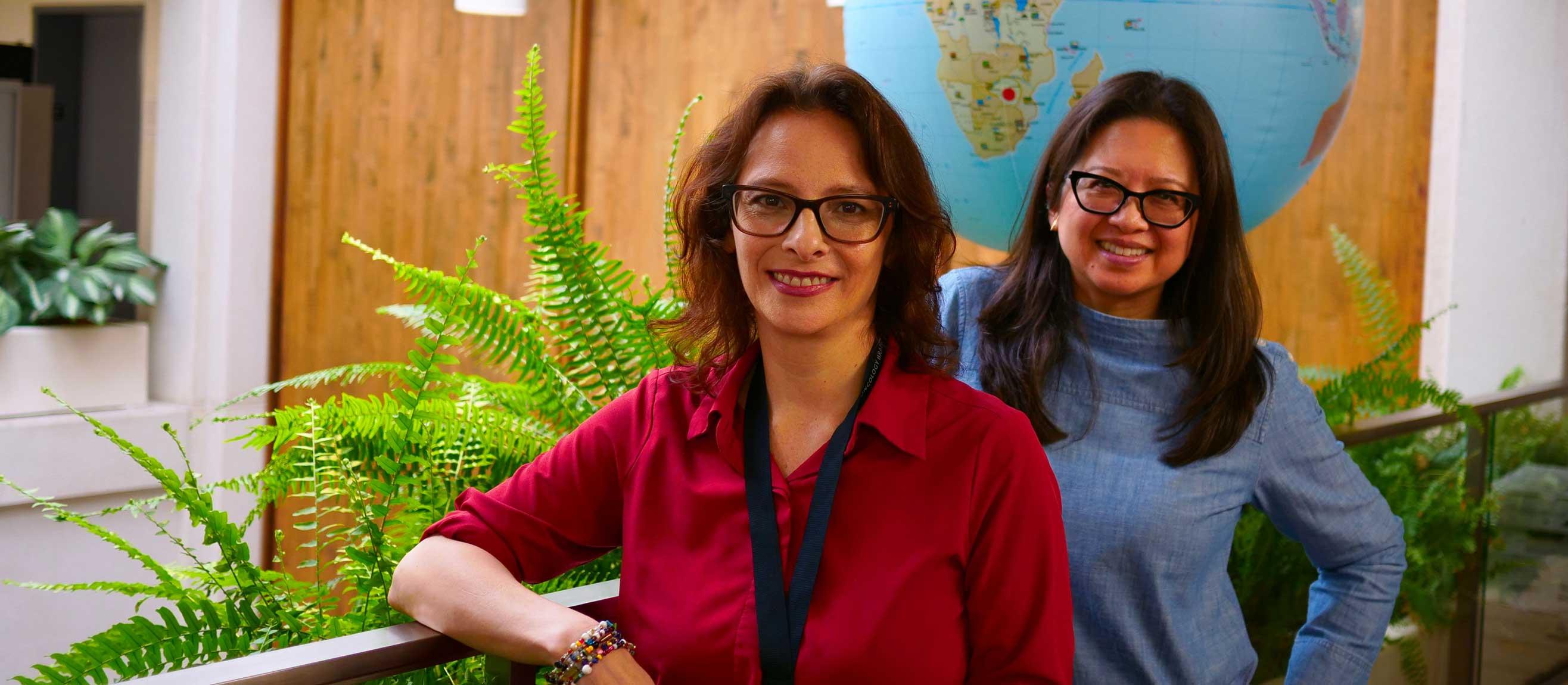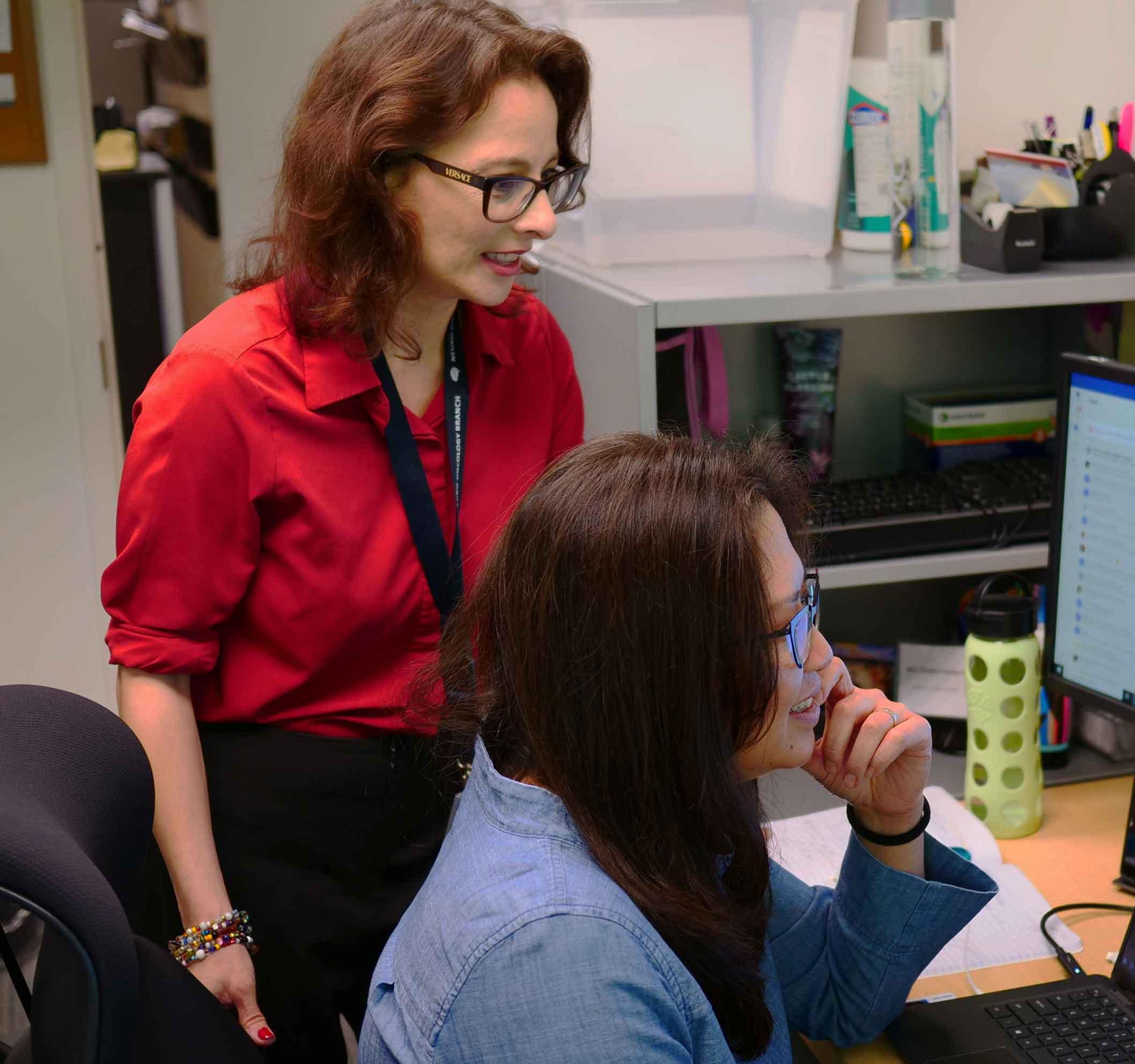Claudia Chambers and Jennifer Reyes are essential members of the Neuro-Oncology Branch, who work diligently and tirelessly to oversee research protocols and guarantee that clinical trials are implemented accurately and safely.
Rebecca Zacuto, Communications Fellow
September 7, 2023
Jennifer Reyes and Claudia Chambers are protocol navigators in the NCI Center for Cancer Research’s Neuro-Oncology Branch (NOB), who make sure that research protocols meet the highest standards and comply with important regulatory and safety regulations.
A research protocol is a document describing the guidelines for conducting a study and outlining the study rationale and methodology. Primarily, Reyes and Chambers’ responsibilities include guiding protocols through scientific and safety review before the study can begin. They also manage regulatory compliance once the study is active, ensuring it is being implemented accurately according to its protocol guidelines, federal codes, and sponsor expectations. This requires submissions to the Institutional Review Boards (IRBs), groups formally designated to review and monitor research involving human subjects, promote ethical standards, and ensure a trial is based on sound science. IRB approval of a clinical trial is required for patient enrollment.
Reyes and Chambers wear many hats, constantly adapting to changing operating procedures and pressing needs. Close collaboration is key to their success and the success of the NOB. The NOB aims to improve treatment and outcomes for adults with primary brain and spine tumors. Thus, Chambers and Reyes’s role in overseeing clinical trial regulatory coordination and implementation fulfills a fundamental objective of the NOB.
“We are making sure that NOB principal investigators are able to receive IRB approval for protocols that address an unmet need that the Branch is trying to fulfill,” Chambers explains.
From Industry and Academia to Brain Cancer Research
Reyes started at the NOB in 2015, managing multi-center protocols as part of the Brain Tumor Trials Collaborative—a national network led by the NOB that investigates new treatments. Then, in 2019, Chambers joined the team. “Without her, I would probably be drowning because it would just be overwhelming; our clinical portfolio has gotten so much bigger over the years,” Reyes remarks.
Prior to the NOB, Reyes worked for Medtronic as a study manager and Chambers worked at the University of Miami as a clinical research coordinator. Reyes always wanted to work in cancer research, so she was excited to join the NOB. At the University of Miami, an academic center, Chambers worked on disease prevention research, gathering aggregate data on how to prevent diseases in large populations of people historically underserved in healthcare. Today at the NOB, her work is specific to the brain and spine tumor patient population. “We help people whose lives are literally on the line,” Chambers says.
Although much of their current work involves managing studies conducted only at NIH, both Reyes and Chambers have extensive experience balancing large project portfolios. “We can communicate and coordinate multi-site trials and make sure that all the sites are on the same protocol page—literally,” says Chambers.
The work of a protocol navigator varies depending on the protocol lifecycle, but Chambers and Reyes are present each step of the way. Research protocols follow a similar pattern: First, the protocol is developed by investigators and undergoes an internal scientific review by Branch leadership and the CCR Scientific Review Committee to assess the scientific merit of the protocol. Then it is submitted to the NIH IRB for an ethical review and approval. The IRB approval process can be iterative, often requiring amendments to the protocol. Other reviews may be required depending on the specifics of the protocol. Reyes and Chambers aid in this process, serving as liaisons between the IRB and the study’s principal investigators until the IRB approves the protocol. Approval means the clinical trial can begin enrollment.
Importantly, protocols must maintain approval while the clinical trial is active. At the maintenance stage, Reyes and Chambers oversee regulatory compliance, ensuring research protocol and sponsor guidelines are being followed and collecting documentation of each trial’s progress. Eventually, the protocol lifecycle ends when a trial is closed, all the information is collected and analyzed and a final report is created
Given their dynamic set of responsibilities, quickly switching gears is a strength of both Reyes and Chambers. Adaptability was especially important during the onset of the COVID-19 pandemic. Reyes describes that time as the most challenging in recent memory. Case by case, the two had to find ways for patients to get necessary study drugs locally when in-person visits to the NIH Clinical Center were suspended. “It was such a huge undertaking,” Reyes recalls. At the onset of the pandemic, with little notice, Chambers and Reyes—together with NOB investigators—had to coordinate with pharmaceutical companies, external investigators, and patients’ primary physicians to usher through protocol changes. Ultimately, they handled it, expediting regulatory processes that usually take many months.
“It's so rewarding knowing that whatever little piece of paper I’m shuffling and submitting is going to really, truly help somebody,” Chambers says.
Gaining Knowledge as Part of an Innovative Team
All protocols eventually are completed or closed, but Chambers and Reyes gain valuable insights from each protocol. There is also a steady pipeline of new protocols, which often means there’s a new study beginning. “The new research that’s coming out of the Branch is exciting,” Chambers says. Both she and Reyes are grateful to be part of such an innovative team. “We work with a great group of people, from the physicians to the administration and everyone in between,” Chambers says.
“Everyone here is so approachable,” Reyes adds. “The physicians are so caring and driven, and being able to see that in the periphery makes me really, really enjoy this work.” Reyes is inspired knowing that her work seeks to improve the lives of people with brain and spine tumors.

